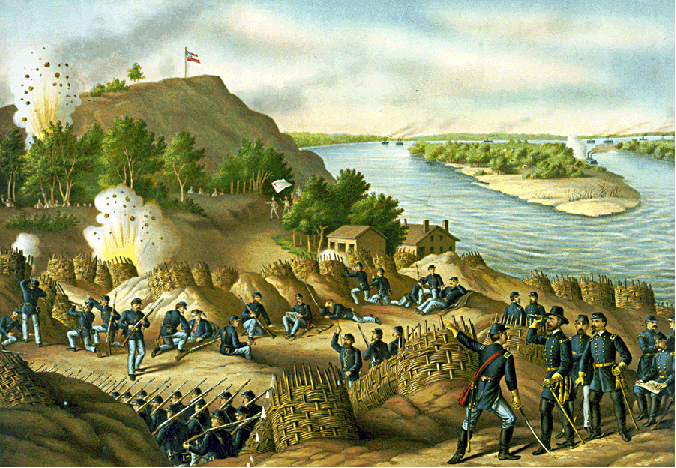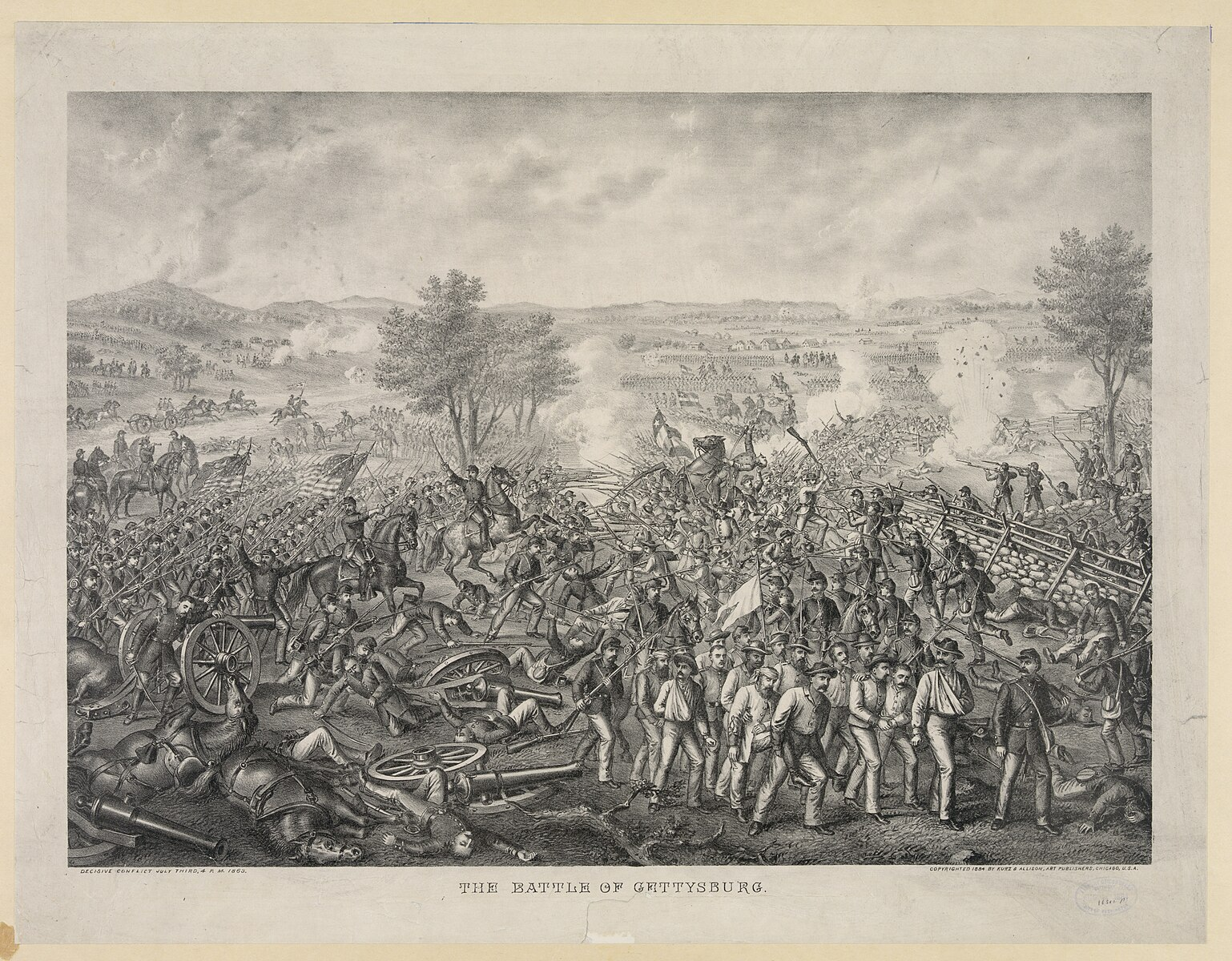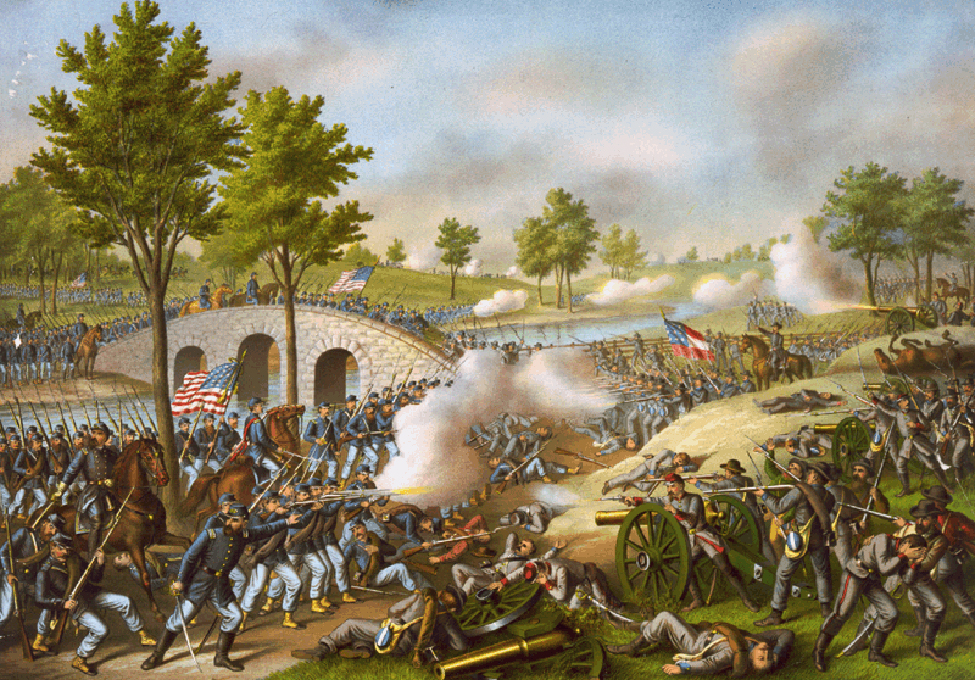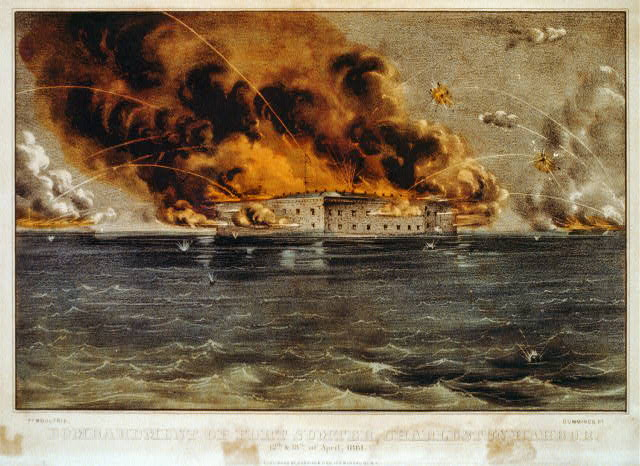Battles of the Civil War Primary Source Set
How did the war transform the nation socially, economically, and politically?
Teacher Directions
This file contains four short essays and historical art depictions of significant Civil War battles. The resources accompany the Battles of the Civil War lesson plan. Students will use the essays to identify which image should accompany each essay in a matching activity. They will also use the resources in the Explanation Game, and as sources for their thesis statement in the assessment. More information on using these resources is available in the lesson plan.
Historical Art Images
Image 1

Image 2

Image 3

Image 4

Essays
The Battle of Fort Sumter
Adapted from: Fort Sumner and the Coming War from BRI’s Life, Liberty, and the Pursuit of Happiness
Lexile: 1080
Word Count: 498
Vocab: resupply, secede, standoff, defiance, hesitant, outgoing, inauguration, fort, confederate, cannon
When Southern states began to leave the Union because of Lincoln’s election, tensions rose. Major Robert Anderson moved his troops to Fort Sumter, off the coast of South Carolina, for safety. Southern militias and Confederate forces, led by General P. G. T. Beauregard, surrounded the fort in the bay, leading to a standoff.
Both sides were hesitant to start a war and wanted a peaceful solution. The outgoing president, James Buchanan, didn’t take strong actions to ease the situation between Lincoln’s election and his inauguration. Buchanan was in a difficult position politically, as giving up the fort would acknowledge the rebellion, while strengthening it could lead to war.
During this period, a ship called Star of the West tried to resupply Fort Sumter but was stopped by Confederate cannons. Tensions continued to increase, and both Northerners and Southerners saw Fort Sumter as a symbol-Northerners as a symbol of Union strength and Southerners as a symbol of Southern defiance.
By March 4, when Lincoln became president, he faced pressure. Reinforcing the fort might start a war, while abandoning it might divide the North and encourage the South. Lincoln decided to wait, hoping the Confederates would make the first move, but supplies were running low. Lincoln’s cabinet was divided. William H. Seward, the Secretary of State, wanted to avoid war and even secretly communicated with the Confederates, suggesting they might surrender the fort. Others in the cabinet, like Postmaster General Montgomery Blair, wanted to reinforce the fort to show the government’s strength. Lincoln got advice from General Winfield Scott to surrender the fort, believing it would help keep the border states in the Union.
Eventually, Lincoln decided to resupply Fort Sumter without adding extra soldiers and informed the Confederates of this. In reaction, Confederate President Jefferson Davis and his cabinet chose to attack, hoping to take the fort before Union ships arrived.
Early in the morning of April 12, 1861 Confederate cannons fired at Fort Sumter for over 30 hours. The Union soldiers could not hold it and surrendered on April 14.
After that, Lincoln called for 75,000 troops to end the rebellion. Many Northerners joined the army, but the call to arms also pushed some remaining slave states to leave the Union. Virginia, then Arkansas, Tennessee, and North Carolina seceded, while other border states debated their next steps. Across the South, people celebrated their victory, but these events led to a war that would last much longer and be much more devastating than anyone expected.
The Battle of Antietam
Adapted from: The Battle of Antietam from BRI’s Life, Liberty, and the Pursuit of Happiness
Lexile: 1100
Word Count: 468
Vocabulary: abolitionist, secession, proclamation, resolve, junction, surrender, reinforcement, abolish
On September 17, 1862, a significant battle took place near Sharpsburg, Maryland, known as the Battle of Antietam. It was the bloodiest single day in American history with nearly 22,000 soldiers wounded or killed. This battle was important because it was the peak of the Confederacy’s attempt to attack during the Civil War, and it gave President Abraham Lincoln a chance to change the focus of the war by fighting against slavery. Frederick Douglass, an abolitionist, called slavery the “stomach of the rebellion.”
To understand Antietam’s importance, we must look at its broader context. The federal government couldn’t abolish slavery in states where it existed, but the secession of slave states allowed Lincoln to use his powers to free slaves as a war measure. Some Union generals treated slaves as captured enemy property, but Lincoln stopped others from freeing slaves without authority because it could upset the border states. These border states were precariously balanced because they allowed slavery but were still a part of the Union. Lincoln worked very hard to keep the border states from leaving the Union
By 1862, there had already been some major battles. Union General Grant won at Shiloh and captured a rail junction in Mississippi, and New Orleans was taken by Union forces. However, Union General McClellan failed to capture Richmond, and Confederate General Lee defeated Union forces at the Second Battle of Bull Run. Lee wanted to invade Maryland to try to weaken the North’s resolve and gain European support for the Confederacy.
The battle began on the morning of September 17 when Union forces attacked. The number of Union troops outnumbered the Confederates with nearly two Union soldiers for every Confederate soldier. The two armies fought for control of land around a church, cornfield, woods, and bridges around Antietam Creek. When Union success seemed close, Lee received reinforcements, preventing a complete defeat.
Lee remained in place the next day, but McClellan didn’t press forward. Despite heavy Union losses, the South’s losses were higher. Lee’s army eventually retreated, resulting in a Union victory. This gave Lincoln an opportunity to issue the preliminary Emancipation Proclamation. This document gave Confederate states until January 1, 1863, to surrender and keep their slaves. If they didn’t, the proclamation would take effect, freeing the slaves. This shifted the war’s purpose to also fight for human liberty and equality.
The Battle of Gettysburg
Adapted from: Gettysburg and Vicksburg, July 4, 1863 from BRI’s Life, Liberty, and the Pursuit of Happiness
Lexile: 1160
Word Count: 604
Vocabulary: fishhook-shaped, disastrously, reframe, climactic, entrench, shadow, offensive, barrage, clash, staggering
The Battle of Gettysburg stands as one of the most significant turning points in the American Civil War. Fought from July 1 to July 3, 1863, it marked the end of Confederate General Robert E. Lee’s second and final invasion of the North. Beyond the immense casualties and tactical maneuvers, Gettysburg became a defining moment in the struggle to preserve the Union and the ideals of democracy.
After his victory at Chancellorsville, Virginia in May, Lee sought to strike a decisive blow by invading Pennsylvania. His goals were bold: to pressure the Union into peace talks, secure foreign recognition for the Confederacy, and disrupt the Union’s war effort. Lee believed that a victory on Northern soil could shatter Union morale and force President Abraham Lincoln to negotiate.
The Union Army of the Potomac, under General Joseph Hooker, initially shadowed Lee’s movements but struggled with leadership issues. In late June, Lincoln replaced Hooker with General George Meade, who quickly took command and prepared to confront Lee. Neither army fully knew the other’s location until their forces unexpectedly clashed near the small town of Gettysburg on July 1.
The first day of fighting saw Confederate forces push Union troops back to high ground south of the town. Despite this early success, Lee’s failure to seize key positions such as Cemetery Hill that evening proved critical. The Union army entrenched itself on strong defensive terrain, forming a fishhook-shaped line from Culp’s Hill to Little Round Top.
On July 2, Lee launched a series of attacks on the Union flanks. The battle’s climactic moment came on July 3 with Pickett’s Charge. Believing the Union center at Cemetery Ridge had been weakened, Lee ordered a massive assault led by General George Pickett. After an intense artillery barrage, 12,000 Confederate soldiers marched across open fields under heavy fire. The attack failed disastrously, with over half of the Confederate forces killed, wounded, or captured. Lee’s army was forced to retreat, marking the end of his invasion.
The cost of Gettysburg was staggering. The Union suffered approximately 23,000 casualties, while Confederate losses ranged from 20,000 to 25,000. It was the bloodiest battle ever fought in North America. Yet the Union victory at Gettysburg, combined with the fall of Vicksburg in the West, marked a decisive shift in the war. The Confederacy would never again mount a major offensive into Union territory.
Four months later, President Lincoln visited Gettysburg to dedicate a cemetery for the battle’s fallen. In his brief but profound Gettysburg Address, he honored the sacrifice of those who fought and reminded the nation of the war’s greater purpose: ensuring that “government of the people, by the people, for the people, shall not perish from the earth.” Lincoln’s words reframed the war as not only a fight to preserve the Union but also a struggle to uphold the ideals of liberty and equality.
Gettysburg’s legacy endures not only as a turning point in the Civil War but also as a symbol of resilience and the enduring fight for a more perfect union. By understanding the significance of this battle, students can appreciate how it shaped the nation’s history and ideals.
The Siege of Vicksburg
Adapted from: Gettysburg and Vicksburg, July 4, 1863 from BRI’s Life, Liberty, and the Pursuit of Happiness
Lexile: 1110
Word Count: 337
Vocabulary: outmaneuver, bombardment, nonstop, swiftly, siege, confederate, swamp, bend, cannon, surrender
The spring of 1863 was a challenging time for the Confederate forces. General Robert E. Lee had just won a big battle against the Union army at Chancellorsville. However, another Union army led by Ulysses S. Grant was surrounding the important city of Vicksburg on the Mississippi River. At the same time, Union forces under William Rosecrans were ready to strike Chattanooga in south central Tennessee. If the Union captured Chattanooga, it could lead to an attack on Atlanta, a key city for the Confederates.
Grant had a clever plan to attack Vicksburg, which was difficult because the city sat on a high hill above a bend in the Mississippi River. The city’s cannons controlled the river below. The area to the north, known as the Mississippi Delta, was a swamp between two rivers, while the Confederates held strong positions on higher ground to the east.
Grant decided on a risky plan even though both his assistant William T. Sherman and President Lincoln had concerns. He chose to leave behind his supply lines and communication routes along the river. Grant marched his troops down the Mississippi’s west bank as navy ships ran past the Confederate guns. After meeting up with the transports, Grant crossed the river south of Vicksburg, where he swiftly outmaneuvered the Confederate forces.
During 17 days after crossing the river, Grant won five major battles, causing twice the number of casualties on the enemy as his own troops suffered. This pushed the Confederate army back into Vicksburg’s defenses. He then secured his supply and communication lines north of the city, linking them to the Mississippi and Yazoo Rivers.
The defenders of Vicksburg held off several direct attacks, so Grant started a siege. He felt confident of victory. On May 24, Grant informed General Halleck that capturing Vicksburg and its soldiers was just a matter of time. Under constant attack, the city finally surrendered on July 4.
Grant’s nonstop bombardment played a key role in the Union’s success at Vicksburg.
